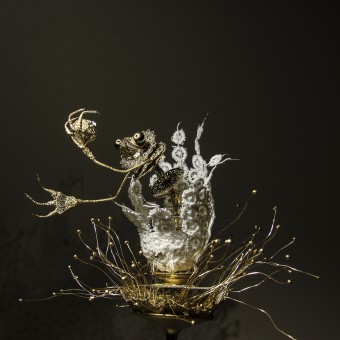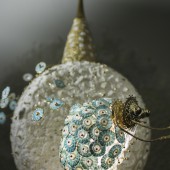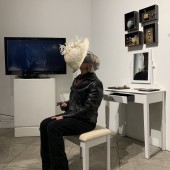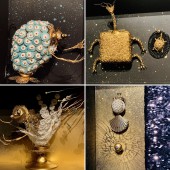
| THE AWARD |
| CATEGORIES |
| REGISTRATION |
| SUBMIT YOUR WORK |
| ENTRY INSTRUCTIONS |
| TERMS & CONDITIONS |
| PUBLICATIONS |
| DATES & FEES |
| METHODOLOGY |
| CONTACT |
| WINNERS |
| PRESS ROOM |
| GET INVOLVED |
| DESIGN PRIZE |
| DESIGN STORE |
| THE AWARD | JURY | CATEGORIES | REGISTRATION | PRESS | WINNERS | PUBLICATIONS | ENTRY INSTRUCTIONS |
Relation Ship Stop Motion Vr Multimedia Installation by Zoey Lin |
Home > Winners > Design #76140 >Interview |
 |
|
FS: What is the main principle, idea and inspiration behind your design?
ZL: Relation Ship is a film and virtual reality experience first inspired by Ghost Ship, a chapter from Roland Barthes' A lover's discourse: Fragments: Though each love is experienced as unique and though the subject rejects the notion of repeating it elsewhere, later on, he sometimes discovers in himself a kind of diffusion of amorous desire; he then realizes he is doomed to wander until he dies, from love to love. Using stop motion organic characters and set design inspired by marine biology, the story consists of two separate philosophical ideas; the concept of Assemblage by Deleuze & Guattari, and the concept of Plissement by Merleau Ponty. Merleau Ponty states in The Visible and the Invisible: The world is like that band of foam on the ocean which appears immobile when seen from an airplane, but which suddenly because it has extended itself by a line, is understood to be shimmering and living from close up. But one also understands that seen from high enough, the amplitude of being will never exceed that of nothingness, nor the noise of the world its silence. (p.64) These ideas inform Relation Ship in terms of content and imagery. Set in an ocean-like environment, complex intricate details shift out of focus to form abstract shapes, like Merleau Ponty’s ideas of shifting perspective in relationship to the distance of the object. Initially, the audience witnesses evocative gestural performance animation of the main character, fish bone queen, giving away precious gifts from her own body. Upon entering the virtual reality environment, the viewer is immersed in a living bodyscape. This idea mirrors the perceived natural world and fluctuations in human relationships. This experimental vr+installation project combines storytelling, philosophy, and biomorphic vr sculpture to allow viewers to experience visceral landscapes exploring the relationship between static exteriors and micro worlds hidden beneath the surface. Audio intertwines space, scale, and sensations by magnifying the subtle sounds created by jewelry, chimes, three stringed instruments, and ambient sounds. Ultimately the viewer will be left with a more intimate understanding of how worlds can be perceived differently depending on your vantage point.
FS: What has been your main focus in designing this work? Especially what did you want to achieve?
ZL: The main focus of the work is to create a walkthrough experience for audiences. Viewers will get involved in the story at the beginning as outsiders to the end as insiders. This project combines storytelling, philosophy, and biomorphic vr sculpture to allow viewers to experience visceral landscapes exploring the relationship between static exteriors and hidden messages beneath the surface. Audio intertwines space, scale, and sensations by magnifying the subtle sounds created by jewelry, chimes, three-stringed instruments, and ambient sounds. Ultimately the viewer will be left with a more intimate understanding of how worlds can be perceived differently depending on your vantage point.
FS: What are your future plans for this award winning design?
ZL: My future plans for this winning design can break down into two parts. One part is that I wish to find sponsorship and cooperation opportunities with fashion or accessories brands and companies. The idea is to cooperate with them by repurposing and assembling their products into characters, sets or props which can become collage artworks as well as developing into short animation contents or series for expanding the story and assets. The other part is long-term goal which I desire to bring all these story ideas, assets and visual components to medicine field for creating interactive works that can serve as visual stimuli to help Parkinson’s patient, patient in pain, mental illness patient, etc.
FS: How long did it take you to design this particular concept?
ZL: It took about two years to develop this whole entire project. In the beginning, it starts with a bunch of materials like found jewelry parts such as necklaces, earrings, findings, etc. and by assembling them together to create main character, Fish-Bone Queen, this process gave me inspiration and confidence to complete the next phase, expanding it into concept design, storyline and shooting stop-motion. And then I co-operated with 3d artist for VR and as well marine biologists, and a soundscape designer.
FS: Why did you design this particular concept? Was this design commissioned or did you decide to pursuit an inspiration?
ZL: It’s the pursuit of my inspiration and vision towards creating a multidisciplinary art experience. I am interested in the duality of what you see versus what lies underneath.
FS: Is your design being produced or used by another company, or do you plan to sell or lease the production rights or do you intent to produce your work yourself?
ZL: I plan to evolve and expand this project further and so far I intend to produce this work further by myself. I am not opposed to licensing or leasing it. I do begin to look for sponsorship as well.
FS: What made you design this particular type of work?
ZL: The work is a pursuit of my inspiration and vision towards creating a multidisciplinary art experience.
FS: Where there any other designs and/or designers that helped the influence the design of your work?
ZL: My design inspiration mostly from material itself and texture of the material. Besides that, I love to feed my creativity by studying marine biological forms and scientific illustration of microorganism under electron microscope. Especially plankton organism illustration works by Ernst Haeckel, it’s great source and reference for me to think about how nature and everything formed. And his drawings give both scientific and aesthetic overview about delicate balances which echoes the concept in philosophical thinking about relationship as fluctuations in “Ghost Ship”, a chapter from Roland Barthes' A lover's discourse: Fragments.
FS: Who is the target customer for his design?
ZL: The target customer for this design and art experience can be almost anyone in the world. However, for this project’s further development, I do set target customer who has high interest in fashion and accessories.
FS: What sets this design apart from other similar or resembling concepts?
ZL: This project is very specific in a way that it combines manifold mediums and materials. It’s a transdisciplinary hybrid of imaginative spatial storytelling concerning the fluctuations in relationships. Moreover, I want to mention about visual punctum and reference from Grand Bazaar for designing main character Fish-Bone Queen and threading concepts together: from color psychology, color science and color philosophy to build macro jewelry world. (you can find detailed description below) Grand Bazaar in Istanbul is one of the largest, mysterious and oldest covered markets in the world and a place full of multicultural, historical and visual art. By viewing diverse designs in products, decorations and objects like mosaic lantern, pottery, turquoise jewelry, rug, etc., it is not hard to find out that a lot visual forms observed and reinterpreted from nature. To be more specific, by analyzing rhythms, orders, shapes in nature, human beings gradually develop and establish advanced geometrical and symmetrical design systems to create more complex and miscellaneous patterns which can be applied to products. At the same time, with dynamic variable in nature like lighting, it affects the color dimension of objects or live forms which contain texture. Under these circumstances, human being realizes color science and constructs color terms. From that point, color psychology, color symbolism and color philosophy developed and took big part in cultures, art and anthropology. For instance, turquoise is the color term from the gem turquoise which has different textures and color dimension affected by lighting. So turquoise is described as a mixture of pale blue and green or slightly greenish shade of cyan on universal basis. It is also because of the ambiguous and organic quality of turquoise, with the passage of time, this color allows more interpretations, experiences and imaginative metaphors from different individual or cultural context to embed within itself. To take an example from medicine perspective, people who practice holistic medicine say that turquoise has a calming effect on patients. They use this color to treat patients prone to panic attacks or mania. To a lesser degree, mainstream psychiatric hospitals also use turquoise and other light shades of blue and green to calm patients by painting the walls in these colors. This is a color that full of story and context and possess wide spectrum of transformative personality by viewing under different imagination, lightings or environments. Based on this organic and creative characteristic, the main character, Fish-Bone Queen and color script were both designed and start its adventure to encounter three other characters for shaping story structure from rising action of giving organs away, climax of giving heart away and resolution of more open-ended exploration. Because of kaleidoscopic, biomorphic and flexible features of Fish-Bone Queen, her body allows to carry combination of reflective turquoise jewelry texture, topic about relationship and experiments between techniques and display formats. At the same time, delicate and fragile jewelry can be the best metaphor to describe the grandiose nature system is composed by and originate from a simple and exquisite unit.
FS: How did you come up with the name for this design? What does it mean?
ZL: Relationship as overlapping topic and psychology of emotion on universal basis in diverse fields: From Literature and Philosophy to Medicine and Science As visual punctum and color reference from turquoise jewelry of Grand Bazaar, part of inspiration about story structure is from philosophical ponderation and empathic understanding by reading Roland Barthes’ ‘A lover’s discourse: Fragments’. Plus, it is also from exploration toward philosophy related to ‘three poisons, six desires and seven emotions’ in traditional Chinese classics, literature and Buddhism collections. Moreover, in sciences side, professionals discuss the brain mechanism of love inside the body. Brain mechanisms that cause you to constantly think about your lover and falling in love involve many mechanisms and chemicals within the brain. So, the three following segments are summary about each disciplines in describing, analyzing, concluding what is relationship. A lover’s discourse: Fragments > inspiration for the concept and title of “Relation Ship” It contains a list of "fragments", some of which come from literature and some from his own philosophical thought of a lover's point of view. Especially form the chapter of “Ghost Ship”; it delineates the philosophy of fluctuations and rhythm in every aspect of our life and world: “Through each love is experienced as unique and thought the subject rejects the notion of repeating it elsewhere later on, he sometimes discovers in himself a kind of diffusion of amorous desire; he then realizes he is doomed to wander until he dies, from love to love.”
FS: Which design tools did you use when you were working on this project?
ZL: Since it’s a multimedia installation projects there are different of materials and tools used to accomplish this piece such as Dragonframe Stop-Motion software, Adobe Suite, Cricut, Agisoft Photogammetry Software, Maya, Redshift, Oculus Rift, Oculus Go, 2K Projection System, etc.
FS: What is the most unique aspect of your design?
ZL: The most unique aspect of this project is combining Stop-Motion and Virtual Reality, to create a walk-through experience, something which has never been achieved before. It’s a transdisciplinary (art, technology and science) hybrid of imaginative spatial storytelling concerning the fluctuations in relationships.
FS: Who did you collaborate with for this design? Did you work with people with technical / specialized skills?
ZL: I worked with two other artists. Kun Xia who is VR visual effect creative director who specializes in creating contents in 3D platforms like Maya and Cinema 4D. Ping Sheng Wu is composer and sound designer of the project and he specialized in experimental sound installation and soundscape creation.
FS: What is the role of technology in this particular design?
ZL: Technology plays significant role in binding physical and virtual contents together. And I specifically want to mention about a technique, photogrammetry which used a lot in this project. The technique photogrammetry can transfer physical object into virtual 3D model which may be defined as the art, science, and technology of obtaining reliable first-hand information about physical objects and the environment. With this technique, it allows to have extreme close observation toward art form and texture in nature which can take closer look into diversity and similarity in structure and shape. Speak of diversity and similarity; it is amazing to see how all kinds of complicated marine species are grouped by very similar geometric components in very creative, functional and organic order. Moreover, in Maya, by experimenting with the scales of photogrammetry models, a small-scale object become a space which can set up the Lat Long camera inside to look around, experiencing the landscape inside the object which is highly complex and architectural in a very organic way. Besides, it is not only an efficient way to have multi-technique cooperation for transferring tangible objects into virtual models but also a reversible process to turn biomorphic virtual design into touchable creations by 3D printing or laser cut which will be beneficial to create physical installation. The intervention of technology expands the context of collage art and blurs the boundary between illusion and non-illusion.
FS: Is your design influenced by data or analytical research in any way? What kind of research did you conduct for making this design?
ZL: The project inspired a lot from diverse disciplinary research in philosophy, medicine, visual reference from Grand Bazaar and marine biology.
FS: What are some of the challenges you faced during the design/realization of your concept?
ZL: When designing the stop motion vr multimedia installation integrating different workflows and elements between stop motion (physical) and virtual reality (computer graphics). And the solution is photogrammetry technique which can turn physical objects into virtual model and export as obj. file which can be edited, retextured in maya.
FS: How did you decide to submit your design to an international design competition?
ZL: Publicity and potential sponsorship and co-operation opportunities with diverse fields.
FS: What did you learn or how did you improve yourself during the designing of this work?
ZL: I learn a lot from the project about how to co-operate transdisciplinary with artists and scientists.
FS: Any other things you would like to cover that have not been covered in these questions?
ZL: n/a
FS: Thank you for providing us with this opportunity to interview you.
A' Design Award and Competitions grants rights to press members and bloggers to use parts of this interview. This interview is provided as it is; DesignPRWire and A' Design Award and Competitions cannot be held responsible for the answers given by participating designers.
| SOCIAL |
| + Add to Likes / Favorites | Send to My Email | Comment | View Press-Release |




